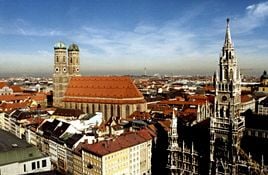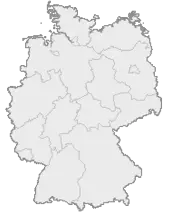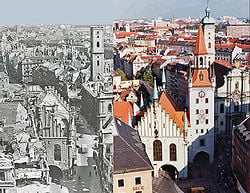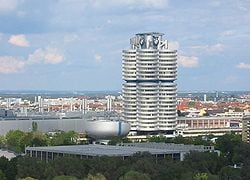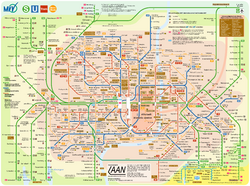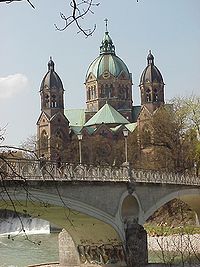Munich
| München Munich | |
| Coordinates | |
| Administration | |
| Country | Germany |
|---|---|
| State | Bavaria |
| Admin. region | Upper Bavaria |
| District | Urban district |
| City subdivisions | 25 boroughs |
| Lord Mayor | Christian Ude (SPD) |
| Governing parties | SPD / Greens / Rosa Liste München |
| Basic statistics | |
| Area | 310.43 km² (119.86 sq mi) |
| Elevation | 519 m (1703 ft) |
| Population | 1,494,608 (31 December 2006)[1] |
| - Density | 4,815 /km2 (12,470 /sq mi) |
| - Urban | 2,600,000 |
| - Metro | 6,000,000 |
| Founded | 1158 |
| Other information | |
| Time zone | CET/CEST (UTC+1/+2) |
| Licence plate | M |
| Postal codes | 80331–81929 |
| Area code | 089 |
| Website | www.muenchen.de |
Munich (German: München, German pronunciation: [ˈmʏnçən] listen ▶; Austro-Bavarian: Minga[2]) is the capital city of Bavaria, Germany. Munich is located on the River Isar north of the Bavarian Alps. Munich is the third largest city in Germany. Ahead of it are Berlin and Hamburg. There are approximately 1.35 million inhabitants within Munich.[3]
The city's motto is "München Mag Dich" ("Munich Likes You"), before 2006 it was "Weltstadt mit Herz". Black and gold - the colours of the Holy Roman Empire - have been the city's official colours since the time of Ludwig the Bavarian.
Munich is not the only location within Bavaria known as "München". Three such locations exist: the one which is known as "Munich"; another which is northeast of the city of Nuremberg; and also a town north of the city of Passau.
Geography
Its native name, München, is derived from the Old German word for Mönche, which means "Monks" in English. This is the reason for the monk on the city's coat of arms.
Munich lies on the elevated plains of Upper Bavaria, about 50km north of the northern edge of the Alps, in the Northern Alpine Foreland, at an altitude of about 520 meters. The northern part of this sandy plateau includes a highly fertile flint area, while the southern part is covered by morainic hills. In between there are fields of fluvio-glacial out-wash, like around Munich. Wherever these deposits get thinner, the ground water can permeate the gravel surface and flood the area, leading to marshes as in the north of Munich.
Munich has a continental climate, strongly modified by the proximity of the Alps. Winters last from December to March. The coldest month is January with an average temperature of 30°F (-2°C). Snow cover is seen for a couple of weeks during winter. Summers are fairly warm with average temperature of 70°F (19°C) in July. The summers last from May until September. The range of temperature between day and night can be extreme. A warm downwind from the Alps (a föhn wind) can change the temperatures within a few hours, even in the winter. Another weather condition known as Alpenstau occurs, most often in spring and summer, which brings unseasonably low temperatures, rain and even snow. The city's altitude and proximity to the northern edge of the Alps mean that precipitation is rather high. Mean annual precipitation is 32 inches (810mm).
The local rivers are the Isar and the Würm.
Size – land area, size comparison Environmental issues Districts
History
Government
Germany is a federal republic in which the president is the chief of state elected for a five-year term by members of the Federal Assembly and by delegates elected by the state parliaments. The chancellor, who is head of government, is elected by an absolute majority of the Federal Assembly for a four-year term. The bicameral parliament consists of the Bundestag of 614 members elected by popular vote under a combination of direct and proportional representation. In the Bundesrat, of 69 votes, state governments are directly represented by votes proportional to population.
Munich's current mayor is Christian Ude of the Social Democratic Party of Germany. Munich has a nearly unbroken history of SPD governments since World War II, which is remarkable because the rest of Bavaria is a conservative stronghold, with the Christian Social Union winning absolute majorities among the Bavarian electorate in many elections at the communal, state, and federal levels.
As capital of the Free State of Bavaria, Munich is an important political centre in Germany and the seat of the Bavarian State Parliament, the Staatskanzlei (the State Chancellery) and of all state departments.
Several national and international authorities are located in Munich, including the German Tax Court and the European Patent Office.
Subdivisions
Since the administrative reform in 1992, Munich is divided into 25 boroughs or Stadtbezirke.
Economy
Munich has the strongest economy of any German city,[4] as well as the lowest unemployment rate (5.6 %) of any German city with more than a million people (the other ones being Berlin and Hamburg).[5] The city is also the economic centre of southern Germany. The initiative “Neue Soziale Marktwirtschaft (INSM)” (New Social Market Economy) and the “WirtschaftsWoche” (Business Weekly) magazine have awarded Munich the top score in their comparative survey for the third time in June 2006. Munich topped the ranking of the magazine “Capital” in February 2005 for the economic prospects between 2002 and 2011 in sixty German cities. Munich is considered a global city and holds the headquarters of Siemens AG (electronics), BMW (car), MAN AG (truck manufacturer, engineering), Linde (gases), Allianz (insurance) and Munich Re (re-insurance). Among German cities with more than 500,000 inhabitants purchasing power is highest in Munich (26,648 Euros per inhabitant) as of 2007.[6] In 2006, Munich blue-collar workers enjoyed an average hourly wage of 18.62 Euros (ca. $ 23)[7].
The breakdown by cities proper (not metropolitan areas) of Global 500 cities listed Munich in 9th position in 2008 [8]. Munich is also a centre for biotechnology, software and other service industries. Munich is also the home of the headquarters of many other large companies like the aircraft engine manufacturer MTU Aero Engines, the space and defence contractor EADS (headquartered in the suburban town of Ottobrunn), the injection molding machine manufacturer Krauss-Maffei, the camera and lighting manufacturer Arri, the semiconductor firm Infineon Technologies (headquartered in the suburban town of Neubiberg), the DRAM company Qimonda, as well as the German or European headquarters of many foreign companies like Precision Plus, McDonald’s and Microsoft.
Munich has significance as a financial centre (secondary to Frankfurt), being home of HypoVereinsbank and the Bayerische Landesbank. It outranks Frankfurt though as home of insurance companies like Allianz and Munich Re.
Munich is the largest publishing city in Europe[9] and home to the Süddeutsche Zeitung, one of Germany's largest daily newspapers. Munich is also home to Germany's largest public broadcasting network, ARD, and its largest commercial network, Pro7-Sat1 Media AG, and is also host to the Burda publishing group.
The Bavaria Film Studios are located in the suburb of Grünwald. They are one of Europe's biggest and most famous film production studios.[10]
Transportation
High speed trains connect Munich to the main cities of Germany and Austria. Munich is an integral part of the motorway network of southern Germany. Motorways from Stuttgart, Berlin, Frankfurt, Lindau, Garmisch Partenkirchen and Salzburg terminate at Munich. The city and its closest suburbs have one of the most comprehensive public transport systems in the world, incorporating the Munich U-Bahn (underground railway), the Munich S-Bahn (suburban trains), trams and buses. Bicycle lanes are widely used, and a modern bike hire system is available in the central area. Franz Josef Strauss International Airport is Germany's second largest airport, with about 34 million passengers a year, and lies some 30 km (19 mi) north east of the city centre.
Demographics
In July 2007, Munich had 1.34 million inhabitants, 300,129 of whom did not hold German citizenship. The city has strong Turkish and Balkan communities. The largest groups of foreign nationals were Turks (43,309), Albanians (30,385), Croats (24,866), Serbs (24,439), Greeks (22,486), Austrians (21,411), and Italians (20,847). 37% of foreign nationals come from the European Union.
With only 24,000 inhabitants in 1700, the population doubled roughly every 30 years. For example, it had 100,000 people in 1852 and then 250,000 people in 1883; by 1901, the figure had doubled again to 500,000. Since then, Munich has become Germany's third largest city. In 1933, 840,901 inhabitants were counted and in 1957, Munich's population passed the 1 million mark.
39.5% of inhabitants are Roman Catholic and 14.2% Protestant (as of 31 December 2005).
Colleges and Universities
Munich is a leading location for science and research with a long list of Nobel Prize laureates from Wilhelm Conrad Röntgen in 1901 to Theodor Hänsch in 2005. Munich has become a spiritual centre already since the times of Emperor Louis IV when philosophers like Michael of Cesena, Marsilius of Padua and William of Ockham were protected at the emperor's court. Both the universities of the Bavarian metropolis, the Ludwig Maximilian University (LMU) and the Technical University (TU or TUM), were found to be worthy of the title of elite university by the selection committee, which consisted of academics and members of the Ministries of Education and Research of the Federation and the German states (Länder). Only Munich's two universities and the Technical University of Karlsruhe have been awarded already in 2006 the title of elite university of Germany and millions of euro in funding.
- University of Munich (LMU), founded in 1472 in Ingolstadt, moved to Munich in 1826
- Technical University of Munich (TUM), founded in 1868
- Munich Business School (MBS), founded in 1991
- Munich University of Applied Sciences (HM), founded in 1971
- Munich Intellectual Property Law Center (MIPLC)
- University of the German Federal Armed Forces, Munich, founded in 1972
- Pionierschule und Fachschule des Heeres für Bautechnik
- Hochschule für Musik und Theater München, founded in 1830
- Akademie der Bildenden Künste München, founded in 1808
- University of Television and Film Munich, (Hochschule für Fernsehen und Film)founded in 1966
- Hochschule für Philosophie München, founded in 1925 in Pullach, moved to Munich in 1971
- Hochschule für Politik München
- Katholische Stiftungsfachhochschule München, founded in 1971
- International Max Planck Research School for Molecular and Cellular Life Sciences[5],
- European School of Management and Technology (esmt)
- Deutsche Journalistenschule, founded in 1959
Scientific research institutions
Max Planck Society
The Max Planck Society, an independent German non-profit research organization, has its administrative headquarters in Munich. The following institutes are located in the Munich metropolitan area:
- Max Planck Institute for Astrophysics, Garching
- Max Planck Institute of Biochemistry, Martinsried
- Max Planck Institute for Extraterrestrial Physics, Garching
- Max Planck Institute for Foreign and International Social Law, München
- Max Planck Institute for Intellectual Property, Competition and Tax Law, München
- Max Planck Institute of Neurobiology, Martinsried
- Max Planck Institute for Ornithology, Andechs-Erling (Biological Rhythms and Behaviour), Radolfzell, Seewiesen (Reproductive Biology and Behaviour)[6]
- Max Planck Institute for Physics (Werner Heisenberg Institute), München
- Max Planck Institute for Plasma Physics, Garching and Greifswald
- Max Planck Institute of Psychiatry, München
- Max Planck Institute for Psychological Research, München
- Max Planck Institute of Quantum Optics, Garching
Other research institutes
- Fraunhofer Institute
Of interest
Architecture
The inner city
At the centre of the city is the Marienplatz - a large open square named after the Mariensäule, a Marian column in its centre - with the Old and the New Town Hall. Its tower contains the Rathaus-Glockenspiel. Three gates of the demolished medieval fortification have survived to this day - the Isartor in the east, the Sendlinger Tor in the south and the Karlstor in the west of the inner city. The Karlstor (destroyed during the Second World War and rebuilt afterwards) leads up to the Stachus, a grand square dominated by the Justizpalast (Palace of Justice) and a fountain.
The Peterskirche close to Marienplatz is the oldest church of the inner city. It was first built during the Romanesque period, and was the focus of the early monastic settlement in Munich before the city's official foundation in 1158. Nearby St. Peter the Gothic hall-church Heiliggeistkirche (The Church of the Holy Spirit) was converted to baroque style from 1724 onwards and looks down upon the Viktualienmarkt, the most popular market of Munich.
The Frauenkirche is the most famous building in the city centre and serves as cathedral for the Archdiocese of Munich and Freising. The nearby Michaelskirche is the largest renaissance church north of the Alps, while the Theatinerkirche is a basilica in Italianate high baroque which had a major influence on Southern German baroque architecture. Its dome dominates the Odeonsplatz. Other baroque churches in the inner city which are worth a detour are the Bürgersaalkirche, the Dreifaltigkeitskirche, the St. Anna Damenstiftskirche and St. Anna im Lehel, the first rococo church in Bavaria. The Asamkirche was endowed and built by the Brothers Asam, pioneering artists of the rococo period.
The large Residenz palace complex (begun in 1385) on the edge of Munich's Old Town ranks among Europe's most significant museums of interior decoration. Having undergone several extensions, it contains also the treasury and the splendid rococo Cuvilliés Theatre. Next door to the Residenz the neo-classical opera, the National Theatre was erected. Among the baroque and neoclassical mansions which still exist in Munich are the Palais Porcia, the Palais Preysing, the Palais Holnstein and the Prinz-Carl-Palais. All mansions are situated close to the Residenz, same as the Alte Hof, a medieval castle and first residence of the Wittelsbach dukes in Munich.
The royal avenues and squares
Four grand royal avenues of the 19th century with magnificent official buildings connect Munich's inner city with the suburbs:
The neoclassical Briennerstraße, starting at Odeonsplatz on the northern fringe of the Old Town close to the Residenz, runs from east to west and opens into the impressive Königsplatz, designed with the "Doric" Propyläen, the "Ionic" Glyptothek and the "Corinthian" State Museum of Classical Art, on its back side St. Boniface's Abbey was erected. The area around Königsplatz is home to the Kunstareal, Munich's gallery and museum quarter (as described below).
Ludwigstraße also begins at Odeonsplatz and runs from south to north, skirting the Ludwig-Maximilians-Universität, the St. Louis church, the Bavarian State Library and numerous state ministries and palaces. The southern part of the avenue was constructed in Italian renaissance style while the north is strongly influenced by Italian Romanesque architecture.
The neo-Gothic Maximilianstraße starts at Max-Joseph-Platz, where the Residenz and the National Theatre are situated, and runs from west to east. The avenue is framed by neo-Gothic buildings which house, among others, the Schauspielhaus and the building of the district government of Upper Bavaria and the Museum of Ethnology. After crossing the river Isar, the avenue circles the Maximilianeum, home of the state parliament. The western portion of Maximilianstrasse is known for its designer shops, luxury boutiques, jewellery stores, and one of Munich's foremost five-star hotels, the Hotel Vier Jahreszeiten.
Prinzregentenstraße runs parallel to Maximilianstraße and begins at Prinz-Carl-Palais. Many museums can be found along the avenue, such as the Haus der Kunst, the Bavarian National Museum and the Schackgalerie. The avenue crosses the Isar and circles the Friedensengel monument passing the Villa Stuck and Hitler's old apartment. The Prinzregententheater is at Prinzregentenplatz further to the east.
Other boroughs
Two large baroque palaces in Nymphenburg and Oberschleißheim are reminders of Bavaria's royal past. Schloss Nymphenburg (Nymphenburg Palace), some 6 km north west of the city centre, is surrounded by an impressive park and is considered to be one of Europe's most beautiful royal residences. 2 km north west of Nymphenburg Palace is Schloss Blutenburg (Blutenburg Castle), an old ducal country seat with a late-Gothic palace church. Schloss Fürstenried (Fürstenried Palace), a baroque palace of similar structure to Nymphenburg but of much smaller size, was erected around the same time in the south west of Munich. The second large baroque residence is Schloss Schleißheim (Schleissheim Palace), located in the suburb of Oberschleissheim, a palace complex encompassing three separate residences: Altes Schloss Schleißheim (the old palace), Neues Schloss Schleißheim (the new palace) and Schloss Lustheim (Lustheim Palace). Most parts of the palace complex serve as museums and art galleries. Deutsches Museum's Flugwerft Schleißheim flight exhibition centre is located nearby, on the Schleißheim Special Landing Field.
St Michael in Berg am Laim might be the most remarkable church out of the inner city. Most of the boroughs have parish churches which originate from the Middle Ages like the most famous church of pilgrimage in Munich St Mary in Ramersdorf. The oldest church within the city borders is Heilig Kreuz in Fröttmaning next to the Allianz-Arena, known for its Romanesque fresco.
Especially in its suburbs Munich, features a wide and diverse array of modern architecture, although strict culturally sensitive height limitations for buildings have limited the construction of skyscrapers to avoid a loss of views to the distant Bavarian Alps. Most high-rise buildings are clustered at the northern edge of Munich in the skyline, like the Hypo-Haus, the Arabella High-Rise Building, the Highlight Towers, Uptown Munich, Münchner Tor and the BMW Headquarters next to the Olympic Park. Several other high-rise buildings are located near the city center and on the Siemens campus in southern Munich. A landmark of modern Munich is also the architecture of the sport stadiums (as described below).
In Giesing is the former McGraw Kaserne, a former U.S. army base, near Stadelheim Prison.
The parks
Munich is a green city with numerous parks. The Englischer Garten, close to the city centre and covering an area of 3.7 km² (larger than Central Park in New York), is one of the world's largest urban public parks, and contains a nudist area, jogging tracks and bridle-paths. It was devised and laid out by Benjamin Thompson, Count of Rumford, an American, for both pleasure and as work area for the city's vagrants and homeless. Nowadays it is entirely a park with a Biergarten at the Chinese Pagoda.
Other large green spaces are the modern Olympiapark and Westpark as well as the parks of Nymphenburg Palace (with the Botanical Garden to the north), and Schleissheim Palace. The city's oldest park is the Hofgarten, near the Residenz, and dating back to the 16th century. Most known for the largest beergarden in the town is the former royal Hirschgarten, founded in 1780 for deer which still live there.
The city's zoo is the Tierpark Hellabrunn near the Flaucher Island in the Isar in the south of the city. Another notable park is Ostpark, located in Perlach-Ramersdorf area which houses the swimming area, Michaelibad, one of the largest in Munich.
Sport
Munich is home to several professional football teams, including 1860 Munich and Germany's most popular and successful club, FC Bayern Munich. The Munich area currently has three teams in the Bundesliga system, which comprises the three top divisions of German football. The city's hockey club is EHC Munich.
Munich has also hosted the 1972 Summer Olympics and was one of the host cities for the 2006 Football World Cup which was not held in Munich's Olympic Stadium but in a new football specific stadium, the Allianz Arena.
Museums
The Deutsches Museum or German Museum, located on an island in the River Isar, is one of the oldest and largest science museums in the world. Three redundant exhibition buildings which are under a protection order were converted to house the Verkehrsmuseum, which houses the land transport collections of the Deutsches Museum. Deutsches Museum's Flugwerft Schleißheim flight exhibition centre is located nearby, on the Schleißheim Special Landing Field. Several non-centralised museums (many of those are public collections at Ludwig-Maximilians-Universität) show the expanded state collections of palaeontology, geology, mineralogy,[11] zoology, botany and anthropology.
The city has several important art galleries, most of which can be found in the Kunstareal, including the Alte Pinakothek, the Neue Pinakothek, and the Pinakothek der Moderne. Alte Pinakothek's rather monolithic structure contains a treasure trove of the works of European masters between the 14th and 18th centuries. The collection reflects the eclectic tastes of the Wittelsbachs over four centuries, and is sorted by schools over two sprawling floors. Major displays include Albrecht Dürer's Christ-like Self-Portrait, his Four Apostles, Raphael's paintings The Canigiani Holy Family and Madonna Tempi as well as Peter Paul Rubens two-storey-high Judgment Day. The gallery houses one of the world's most comprehensive Rubens collections. Before World War I, the Blaue Reiter group of artists worked in Munich. Many of their works can now be seen at the Lenbachhaus. An important collection of Greek and Roman art is held in the Glyptothek and the Staatliche Antikensammlung (State Antiquities Collection). King Ludwig I managed to acquire such famous pieces as the Medusa Rondanini, the Barberini Faun and the figures from the Temple of Aphaea on Aegina for the Glyptothek. The Kunstareal will be further augmented by the completion of the Egyptian Museum.
The famous gothic Morris dancers of Erasmus Grasser are exhibited in the Munich City Museum in the old gothic arsenal building in the inner city.
Another area for the arts next to the Kunstareal is the Lehel quarter between the old town and the river Isar: The State Museum of Ethnology in Maximilianstrasse is the second largest collection in Germany of artifacts and objects from outside Europe, while the Bavarian National Museum and the adjoining Bavarian State Archaeological Collection in Prinzregentenstrasse rank among Europe's major art and cultural history museums. The nearby Schackgalerie is an important gallery of German 19th century paintings.
The former Dachau concentration camp is 16 kilometres outside the city.
Arts and literature
Munich is a major European cultural centre and the domain of many prominent composers including Orlando di Lasso, W.A. Mozart, Carl Maria von Weber, Richard Wagner, Gustav Mahler, Richard Strauss, Max Reger and Carl Orff. With the Biennale, founded by Hans Werner Henze the city still contributes to modern music theatre.
The Nationaltheater where several of Richard Wagner's operas had their premieres under the patronage of Ludwig II of Bavaria is the home of the Bavarian State Opera and the Bavarian State Orchestra. Next door the modern Residenz Theatre was erected in the building that had housed the Cuvilliés Theatre before World War II. Many operas were staged there, including the premiere of Mozart's "Idomeneo" in 1781. The Gärtnerplatz Theatre is a ballet and musical state theatre while another opera house the Prinzregententheater has become the home of the Bavarian Theatre Academy. The modern Gasteig center houses the Munich Philharmonic Orchestra. The third orchestra in Munich with international importance is the Bavarian Radio Symphony Orchestra. Its primary concert venue is the Herkulesaal in the former city royal residence, the Residenz. A stage for shows, big events and musicals is the Deutsche Theater.
Next to the Bavarian Staatsschauspiel in the Residenz Theatre (Residenztheater), the Munich Kammerspiele in the Schauspielhaus is one of the most important German language theatres in the world. Since Gotthold Ephraim Lessing's premieres in 1775 many important writers have staged their plays in Munich such as Christian Friedrich Hebbel, Henrik Ibsen and Hugo von Hofmannsthal.
Prominent literary figures worked in Munich especially during the final centuries of the Kingdom of Bavaria such as Paul Heyse, Max Halbe, Rainer Maria Rilke and Frank Wedekind. The period immediately before World War I saw particular economic and cultural prominence for the city. Munich, and especially its suburb of Schwabing, became the domicile of many artists and writers. Thomas Mann who also lived there wrote in his novella Gladius Dei about this period "Munich shone". Munich remained a centre of cultural life also during the Weimar period, as figures such as Lion Feuchtwanger, Bertolt Brecht and Oskar Maria Graf were active. In 1919 the Bavaria Film Studios were founded.
Munich had already become an important place for painters like Carl Rottmann, Lovis Corinth, Wilhelm von Kaulbach, Carl Spitzweg, Franz von Lenbach, Franz von Stuck and Wilhelm Leibl when Der Blaue Reiter (The Blue Rider), a group of expressionist artists, was established in Munich in 1911. The city was home to the Blue Rider's painters Paul Klee, Wassily Kandinsky, Alexej von Jawlensky, Gabriele Münter, Franz Marc, August Macke and Alfred Kubin.
Hofbräuhaus and Oktoberfest
The Hofbräuhaus am Platzl, arguably the most famous beer hall worldwide, is located in the city centre. It also operates the second largest tent at the Oktoberfest, one of Munich's most famous attractions. For two weeks, the Oktoberfest, attracts millions of people visiting its beer tents ("Bierzelte") and fairground attractions. The Oktoberfest was first held on 12 October 1810 in honour of the marriage of crown prince Ludwig to Princess Therese von Sachsen-Hildburghausen. The festivities were closed with a horse race and in the following years the horse races were continued and later developed into what is now known as the Oktoberfest. Despite its name, most of Oktoberfest occurs in September. It always finishes on the first Sunday in October unless the German national holiday on 3 October ("Tag der deutschen Einheit" - Day of German Unity) is a Monday or Tuesday - then the Oktoberfest remains open for these days.
Culinary specialities
The Weißwürste ('white sausages') are a Munich speciality. Traditionally eaten only before 12:00, (a tradition dating to a time before refrigerators,) these morsels are often served with sweet mustard and freshly baked pretzels. Leberkäs, Bavarian baked sausage loaf often served with potato salad, are another delicacy of the region.
The most famous soup might be the Leberknödel Soup. Leberknödel is a bread dumpling seasoned with liver and onions.
Schweinebraten (pot roasted pork) with Knödel (dumplings made from potatoes and/or white bread) and Kraut (cabbage) or a Schweinshaxe (pork knuckle) are served as lunch or dinner. Beuscherl, a plate of lung, heart and spleen is also served with dumplings.
Popular as dessert is the Apfelstrudel apple strudel with vanilla sauce, the Millirahmstrudel a cream cheese strudel, Dampfnudeln (yeast dumplings served with custard) or Auszogene, a fried pastry shaped like a large donut but without a hole. Not forgetting the famous Prinzregententorte created in honour of the prince regent Luitpold.
Some specialities are typical cold dishes served in beergardens: Obatzda is a Bavarian cheese delicacy, a savoury blend of smashed mellow camembert prepared with cream cheese, cut onions and spicy paprika (and sometimes some butter). It's often served in the beergardens as well as Radi (radish), white radish cut in thin slices and salted, and Münchner Wurstsalat, Munich's famous sausage salad with thinly sliced Knackwurst marinated in vinegar and oil with onions on a bed of lettuce. Popular grilled meals include Steckerlfisch is a local fish, such as trout or whitefish, speared on a wooden stick, grilled and smoked on charcoal - the typical feature is the crispy skin. Another classic is A hoibs Hendl (half a grilled chicken). A Maß (die Maß) is a litre of beer, a Radler consists of half beer and half lemonade.
Local beers brewed in Munich
Munich is famous for its breweries and the Weißbier (or Weizenbier, wheat beer) is a speciality from Bavaria. Helles with its translucent gold colour is the most popular Munich beer today, although it’s not very old (only introduced in 1895). Helles and Pils have almost ousted the Munich Dark Beer (Dunkles), which gets its dark colour from burnt malt, the most popular beer in Munich within the 19th century. Starkbier is the strongest Munich beer, containing 6–9 percent alcohol. It is dark amber and has a heavy malty taste. It is available and popular during the Lenten Starkbierzeit (strong beer season), which begins on or before St. Joseph’s Day (March 19th). There are around 20 major beer gardens, with four of the most famous and popular being located in the Englischer Garten and the largest one in the Hirschgarten.
- Augustiner Bräu
- Hacker-Pschorr
- Hofbräu
- Löwenbräu
- Paulaner
- Spaten-Franziskaner-Bräu
Markets
The Viktualienmarkt is Munich's most popular market for fresh food and delicatessen. A very old feature of Munich's Fasching (carnival) is the dance of the Marktfrauen (market women) of the Viktualienmarkt in comical costumes.
The Auer Dult is held three times a year on the square around Mariahilf church and is one of Munich's oldest markets, well known for its jumble sale and antiques.
Three weeks before Christmas the Christkindlmarkt opens at Marienplatz and other squares in the city, selling Christmas goods.
Nightlife in Munich
Nightlife in Munich is thriving with over 6,000 licensed establishments in the city, especially in Schwabing, which is still the main quarter for students and artists. Some notable establishments are: the touristy Hofbräuhaus, one of the oldest breweries in Munich, located in the city centre near Tal; Kultfabrik and Optimolwerke, former industrial areas converted to host many different discos and pubs; Munich's gay quarter is in Isarvorstadt, surrounding the Staatstheater am Gärtnerplatz, also known as the Glockenbachviertel.
Around Munich
The Munich agglomeration sprawls across the plain of the Alpine foothills comprising about 2.6 million habitants. Several smaller traditional Bavarian towns and cities like Dachau, Freising, Erding, Starnberg, Landshut and Moosburg are today part of the Geater Munich Region formed by Munich and the surrounding districts making up the metropolitan area of about 4.5 million people.
- StadtpfarrkircheStJakob.JPG
Dachau
- Erding center.JPG
Erding
- Freisinger Dom aussen 01.jpg
Freising
- Cloister Fuerstenfeld Portal.jpg
Fürstenfeldbruck
- Landsberg Befestigung 4.jpg
Landsberg
- Kastulusmünsterp.jpg
Moosburg
ReferencesISBN links support NWE through referral fees
- ↑ Bayerisches Landesamt für Statistik und Datenverarbeitung. www.statistik.bayern.de (in German). Retrieved 2008-05-17.
- ↑ Names of European cities in different languages#M
- ↑ http://www.region-muenchen.com/themen/info_en/info_en.htm Region Munich
- ↑ [1] Study conducted by INSM (New Social Market Economy Initiative) and WirtschaftsWoche magazine
- ↑ [2] Bundesagentur für Arbeit (Federal agency for work)
- ↑ [3] Germany, statistics, studies, consumers
- ↑ Landeshauptstadt München, Direktorium, Statistisches Amt: Statistisches Jahrbuch 2007, page 206 (Statistical Yearbook of the City of Munich 2007)
- ↑ [4] Fortune Global 500 annual ranking of the world's largest corporations
- ↑ Munich Literature House: About Us. Retrieved February 17, 2008.
- ↑ Bavaria Film GmbH. Retrieved February 17, 2008.
- ↑ Museum Reich der Kristalle München
Further reading
External links
- Münchner Verkehrs- und Tarifverbund Public transport, retrieved August 31, 2008.
- Toytown Munich Community website, retrieved August 31, 2008.
- Europe Pictures - Munich
- Geocoded Pictures of Munich
- Munich City Panoramas - Panoramic Views and virtual Tours
- Tales from Toytown - Photos of Munich
- A Photo-Enthusiasts View of Munich
Credits
New World Encyclopedia writers and editors rewrote and completed the Wikipedia article in accordance with New World Encyclopedia standards. This article abides by terms of the Creative Commons CC-by-sa 3.0 License (CC-by-sa), which may be used and disseminated with proper attribution. Credit is due under the terms of this license that can reference both the New World Encyclopedia contributors and the selfless volunteer contributors of the Wikimedia Foundation. To cite this article click here for a list of acceptable citing formats.The history of earlier contributions by wikipedians is accessible to researchers here:
The history of this article since it was imported to New World Encyclopedia:
Note: Some restrictions may apply to use of individual images which are separately licensed.
